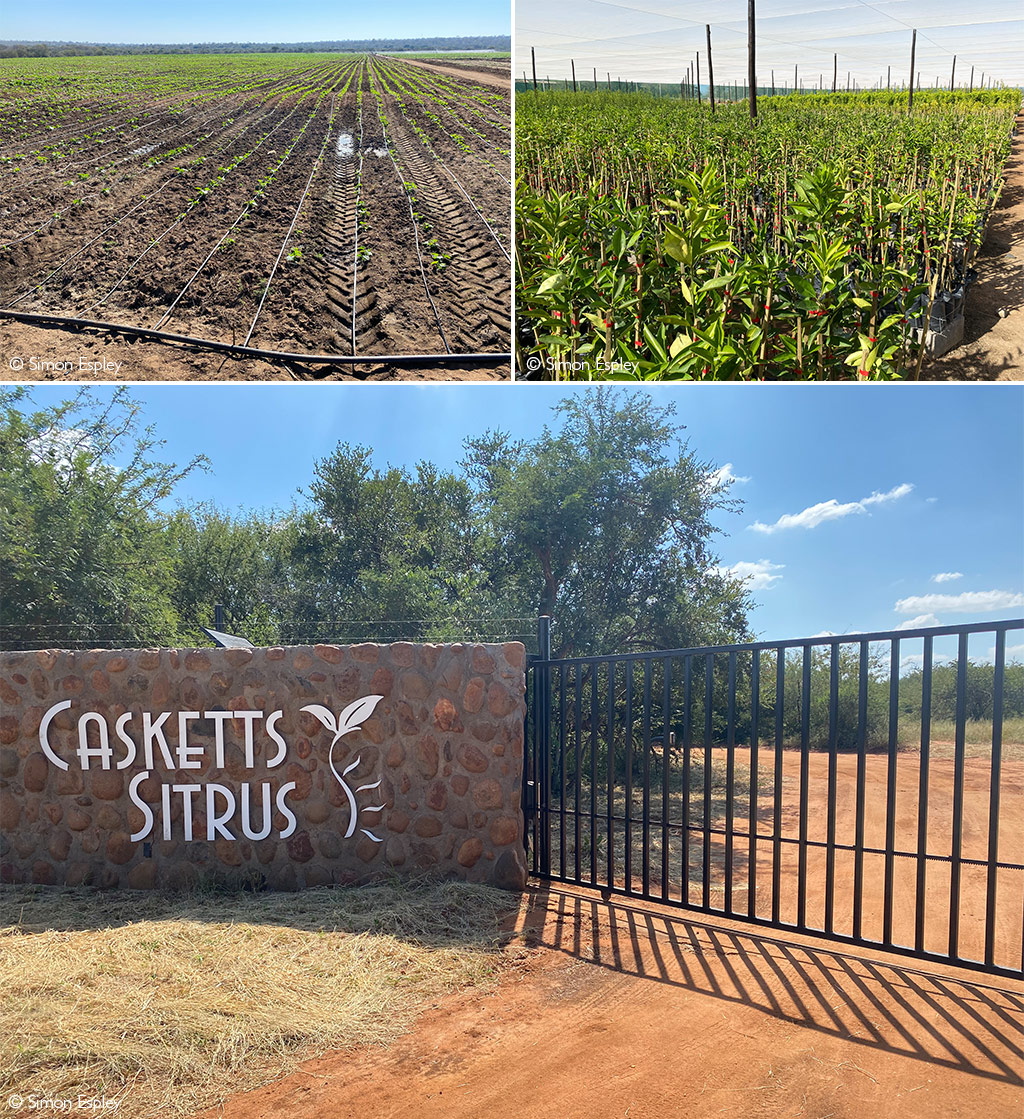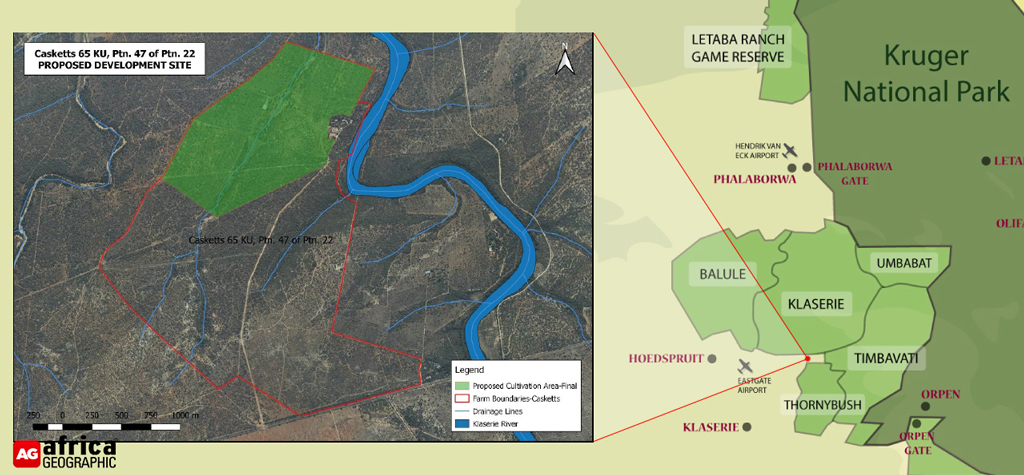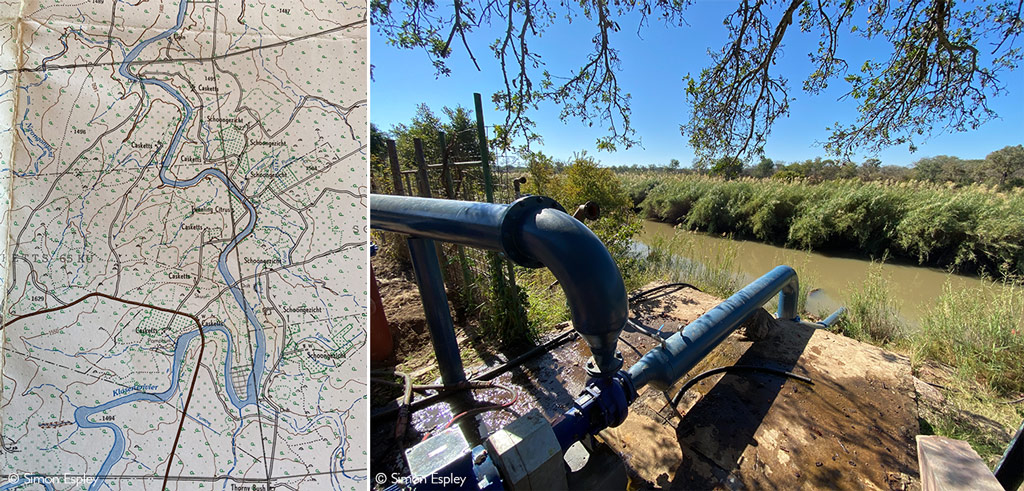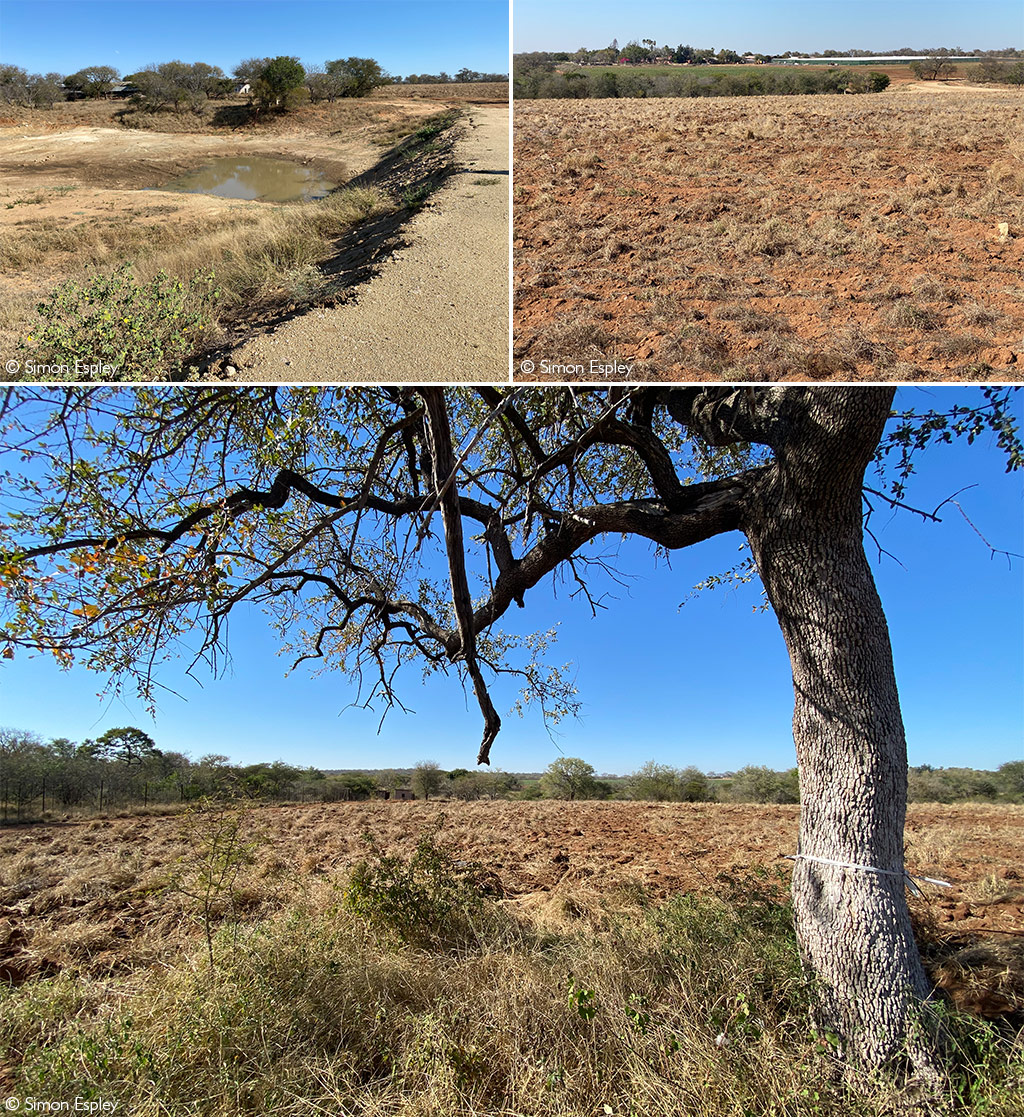A new intensive citrus farm bordering the renowned Timbavati and Klaserie private nature reserves – Greater Kruger – appears a fait accompli.
I did not understand this reality when I arranged to meet farmer Kobus van Staden at his new project Casketts Sitrus. But I do now.
Van Staden met me at the gate to Casketts and jumped into my venerable Landy Defender to guide me to the farm HQ. I had loaded up a key question: whether he would consider dropping the intensive farming idea and instead partner with others to open a lodge or other tourism service. That question disappeared like mist under the African sun when we emerged from hectares of scrappy thorn scrub to a vista of ploughed fields with rows of plastic irrigation pipes and a newly-planted cash crop of gem squash seedlings. Here and there, on the cleared fields, large marula, leadwood and knobthorn trees had been left standing their ground defiantly. I saw a large area enclosed by shade-net to the side of the fields – sheltering the citrus saplings that will be planted once the season turns and the cash crop is harvested. About 60,000 trees.
OK then, this is a done deal. With that level of investment, there is little realistic chance of an about-turn in land use and rehabilitation of this farm back to ‘bushveld’ status.

I followed van Staden and fellow Casketts owner Jurie van Vuren to a rustic farmhouse veranda overlooking the Klaserie River and beyond to prime Big 5 safari country – the Greater Kruger. What followed was a cordial but frank discussion, followed by a tour of the farm. My every request for information was met without hesitation, and I was left free to photograph anything – including a cleared area beyond the authorised limits.
There has been much said and written about this controversial situation, and the battle became intensely personal, with van Staden taking body blows to his reputation. Team AG initially requested members of the public to exercise their legal right to have a say in December 2018 and then followed up with regular opinions from respected scientists opposed to the new farm, who also questioned the Impact Report. However, what we had failed to do to date was speak to the farmer, a situation I was keen to remedy.
Context to these notes:
I was and remain opposed to this intensive farming operation on the border of the Greater Kruger. BUT I now understand better the context and the complexities, and I hope that my notes below will resource you to debate this controversial topic from a factual perspective.

The farm Casketts
The 420ha farm was subdivided and purchased from former owner Rocco Gioia for about R35million (US$2,5m) – and is entirely surrounded by Gioia’s remaining farms. The authorities have authorised 102 hectares for irrigated citrus orchards based on an existing water right.
The farm was purchased in 1967 by Libero Gioia, who farmed cattle, tomatoes and cattle fodder. When his son Rocco took over the farm, he focused on tobacco, mangoes, sweet potatoes, tomatoes, chillies, lucerne, blue buffalo grass and various game species – some of which are hunted. Rocco Gioia continues to utilise the remaining 2,400ha surrounding Casketts primarily for game farming.
Water rights
Casketts has a legal right to extract sufficient water to irrigate 120 hectares. This right was granted in 1950 when the Klaserie Irrigation Board was constituted by the then governor-general of the Union of South Africa.
That water offtake is sufficient for Casketts purposes – they have made no application for additional offtake, and no other water use license is required in terms of the Water Act.
The Klaserie Dam was built in the 1950s on the Klaserie River about 22 km upstream of Casketts specifically to enable the farmers to access reliable water for their crops. The total water listed for farmers from the dam is to irrigate 1,100ha, of which about 500ha is currently utilised.
Water is regularly released from the dam to provide the farmers’ required water and maintain the river’s ecological state (theoretically). Casketts has a pump to extract that water directly from the river as it flows past. This water is then pumped to earth dams for storage and then irrigation.

Water rights conflict of interest?
A perceived conflict of interest has been raised in some quarters because Casketts’ co-owner Jurie van Vuren is also a board member (and chairperson) of the Klaserie Irrigation Board. The general suspicion being whispered is that he either used his position to grant the necessary water rights (not possible because the water rights were allocated in 1950, as described above) or will influence future decisions related to water and Casketts.
The Department of Water Affairs owns the Klaserie Dam, and the relevant farmers own allocated water volume rights. The only way to be on the Irrigation Board is if you are a water right owner. All board members are beneficiaries of decisions made by themselves. In other words, this is not a public democracy; it’s a club of people who own rights to a water resource and who rely on their collective intent and skills to best manage that resource. This is no different to the many other forms of cooperative resource management boards, such as those governing the Timbavati and Klaserie private nature reserves (PNR), for example.
When I questioned van Vuren about the timing of his appointment to the Board, he advised: “I became a shareholder of Casketts on 09 September 2018 and a board member of Klaserie Irrigation Board on 23 November 2018.”
So, van Vuren was not alive when the water right was granted. Could he conceivably influence water-related decisions in favour of Casketts? Yes, absolutely. But then, so could every other Klaserie Irrigation Board member serve their interests in this way. The conflict of interest is there, it’s intentional, and it is no different to other boards that serve a similar purpose. Perhaps boards such as these – with significant environmental impact – should be opened up to include independent board members? But that’s a conversation for another day.
The farm dams
Casketts has four long-existing dams on a drainage line that feeds into the Klaserie River. Two still hold water, and two were breached during the 2012 floods and are currently empty. Van Staden has repaired the largest of the broken dams and indicated that he wouldn’t repair the other dam. The EIA conditions stipulate that he cannot increase the size of the repaired dam, from the original 70m length, 6m width and 5m height.
Our tour of Casketts included the dam in question. It was apparent that the dam floor had been scraped – “to remove the accumulated sand from the rocky floor of the dam”, he told me. The repaired dam wall does not appear to exceed the permitted 5m height limit. The wall is now wider than 6m, increased to 12m in places. Van Staden’s explanation that this was to ensure no further breaches during floods makes sense, as does his further justification that the wider wall now permits them to use the dam wall as the main road to access the portion of the farm on the other side of the drainage line with heavy farming vehicles. In this way, they avoid making roads through the protected riverine area. The length of the wall has been increased to allow for a spillway to prevent future floods – the original dam did not have a spillway. The spillway does not increase the holding capacity of the dam.
I am no dam expert (obviously), but I was no more alarmed at what I saw here than I was last year when one of the largest landowners in Timbavati PNR repaired the 2012 flood-damaged dam wall at his lodge on the Nhlaralumi River. He moved large amounts of sand from the dam floor. I was alerted to this by a downstream property owner who was surprised to see little or no flowing water immediately after excellent rains early this year, when the Nhlaralumi was flowing bank-to-bank a short distance upstream. This is a large dam with no agricultural benefit. The flow of this non-perennial river is impeded to provide a visually appealing lodge site and attract wildlife for those gin and tonic moments. As an aside, one reason for the concentration of elephants in the Greater Kruger during the dry months, and subsequent destruction of local trees, is these man-made dams. But that’s another discussion entirely.
Do these increases in width and length of the Casketts dam wall represent an opportunity for legal and punitive action? Time will tell. Should every dam repair, regardless of where, be appropriately scrutinised for environmental reasons? Certainly.
Protected trees and clearing beyond the demarcated area
The EIA stipulates that no protected trees may be removed during the bush clearing process, without a permit. Van Staden assured me that no such trees were removed, but of course, I have no way to verify that claim. Google Earth shows old fields with scant natural cover – much like the damaged scrubland we drove through on the way from the gate to the orchards. Nevertheless, there were some sizeable, defiant leadwood, marula, and knobthorn trees dotted amidst the moonscape – and each had been marked with plastic tape.
I noticed that part of the clearing was taking place beyond the clearly defined EIA boundary limits and questioned van Staden about that. He explained that he had to decide how to make up the permitted 102ha of land to be cleared because some of the area approved for clearing featured more trees than the area he chose to clear. This transgression did not result in him exceeding the 102ha allocation, and he seemed philosophical about potential ramifications.

Chemicals and groundwater contamination
Another primary concern is how Casketts will ‘deal with’ the overload of insects that can be expected to invade the citrus orchards from the neighbouring biodiversity-rich Greater Kruger area. The likely chemical warfare will surely impact groundwater pollution and wildlife that feeds on poisoned insects.
Van Staden dismissed my concerns – mainly on the basis that Casketts will, like his other farms, be GLOBALG.A.P. certified to export their fruit and that the requirements are so precise, traceable and transparent that there is no room for errors. He also emphasised that he requires his chemical processes to be bee-friendly to ensure the fertilisation by bees of his orchards. He mentioned using predator insects as one tactic to remove insects that could harm his citrus crop. He further added that GLOBALG.A.P. is very sensitive to negative social media publicity and extra vigilant during the annual audit process.
I found myself silenced by his confident dismissal and was not knowledgeable enough to counter. And yet, I am mindful that scientists cite the ubiquitous use of agricultural pesticides and the spread of monoculture crops as a primary reason for the fall-off of the world’s insect populations. Other scientists conclude that insect declines are linked to the intensification of agriculture in the last 50 years.
Legal action and the authorities
Much of the legal tussle going on between the parties seems to hinge on whether any of the bush clearing occurred while the appeal process was underway, which would be illegal. This Daily Maverick article provides the relevant detail, and I won’t go into this matter any further. Van Staden did not want to comment on this matter because of the impending legal actions, but he did express frustration at the costly delays related to the appeal process. In this timeline below, it becomes clear that the authorities (Office of the M.E.C., Limpopo Department of Economic Development, Environment & Tourism (LEDET)) took 21 months to finalise an appeal process that they are obligated to complete in 90 days. Despite the LEDET tardiness, appeals lodged by some parties after the stipulated 20-day deadline were rejected as being late!
Legal timeline
23/03/2017: Application for subdivision of property;
24/07/2017: Dept. Agriculture grants permission to cultivate the property;
28/11/2017: Subdivision of the property approved;
15/10/2018: Transfer of property into the name of Soleil Mashishimale Pty Ltd;
15/10/2018: EIA process initiated;
02/08/2019: EIA approved;
02/08/2019: Appeals lodged by Timbavati PNR, Klaserie PNR and Elephants Alive, amongst others. Various other appeals were not submitted timeously and therefore dismissed;
24/03/2021: Above appeals dismissed, approval of the EIA granted on 02/08/2019 upheld;
04/2021: Application by above appellants against the M.E.C: LEDET & Others for a judicial review of the decision by the M.E.C.
04/2021: Urgent application by above appellants to prevent any further development until the judicial review has been finalised;
08/06/2021: Dismissal of the above urgent application.
It is unlikely that the above application (in bold) will see the courtroom sooner than eighteen months from now – we can expect Covid-related delays – and by then, the citrus trees will be in the ground, and the farming enterprise will be well on its way.
WHY is this farm not included in Greater Kruger?
Farms in this area are sought-after because they are close to the Greater Kruger and could one day conceivably be incorporated into this successful conservation endeavour, which would add significantly to their value and revenue-generation potential.
I was curious as to how this valuable wildlife land could end up as a citrus farm. My enquiry as to why Casketts was not fenced into the prestigious Timbavati or Klaserie private nature reserves was referred to the previous owner, Rocco Gioia. As a local landowner, Gioia cooperates extensively with Timbavati and Klaserie management during their anti-poaching efforts to protect their rhino – his farms border those reserves – and maintains a good relationship with them.
HOWEVER, Gioia pointed out in an email that his requests for his farm to be included in the Timbavati Private Nature Reserve were turned down.
I discussed these historic rejections with a former Timbavati warden, who confirmed that the decision-makers viewed Gioia’s property as not suitable for inclusion. We also extracted this statement from the Timbavati chairman, Anthony Hare: “We took a decision based on our ability to absorb a large property, beyond our natural footprint. This would have meant considerable extra resources and cost required, and without being able to leverage the existing operations to take it on. We did not rule it out forever, just at the time.”
Gioia also mentioned several attempts to have his farm included in the Klaserie Private Nature Reserve, including one request based on operating as a hunting camp. We were advised by the current Klaserie warden, Colin Rowles, that according to his records, Gioia applied at some stage in the 1990s but subsequently withdrew that application.
Gioia provided several examples of specific requests made by him to both reserves going back about 30 years, and the reasons for rejection varied each time. His obvious frustration provides a clear indication that things need to change if we are to avoid similar scenarios repeating themselves. Angry neighbours, of whatever level of economic empowerment, make for bad conservation bedfellows.
Elephants and oranges
The concern about animals being killed by various means as they target the citrus trees is valid, and this scenario is mirrored on most commercial farms in the world. Animals will die in their pursuit of nourishment from these trees – from insects to birds and mammals. Hopefully, there will be mitigation strategies in place (van Staden says there will be), but the reality is that some animals will die.
The issue that has hogged the limelight has been the likelihood of elephants targeting the oranges and what will happen if and when they do.
Van Staden seemed open to any considered, well-managed collaborations to reduce the risk of this happening and to prevent elephant crop-raiders from being killed or harmed by working with local authorities and NGOs. He seemed to be relaxed about this risk and confused about the focus on elephants as the main issue at play. “Elephants will have to come through four fences before they get to my property”, he said – the Greater Kruger fence, a neighbour farm fence, the Gioia farm fence and the Casketts farm fence. The EIA requires him to install an elephant-proof fence on Casketts – and he assured me that this would be done.
To help me understand the elephant-oranges issue better, I spoke to Kevin Leo-Smith, manager of Rietspruit Game Reserve, just outside Hoedspruit and across the busy R40 road from the Greater Kruger area in question. His input is very relevant because he recently managed the reintroduction of elephants to Rietspruit, which borders directly onto established citrus farms. The neighbour consultation process involved explaining to concerned farmers his mitigation procedures if elephants escape Rietspruit to raid the citrus orchards.
Leo-Smith explained that there is no scientific evidence that elephants specifically target citrus as a general rule. There is plenty of anecdotal evidence of elephants eating oranges in farm orchards, but elephants target just about anything edible. For example, three bull elephants that escaped from the nearby Balule Private Nature Reserve (Greater Kruger) about four years ago followed the Blyde River upstream as they pursued their natural dispersal instinct. They did not make their way to nearby citrus farms; instead, they feasted on the mango orchards along the way before being captured and returned to the reserve. The Malelane and Komatipoort areas, about 250 km south of Hoedspruit, are awash with huge sugar cane and citrus farms, amongst other crops, and few if any elephant issues are reported by farmers.
Leo-Smith explained that bull elephants in particular will, through learned behaviour, regularly visit sources of reliable nutrition – including citrus crops – but that they are more likely to target grass crops like sugar cane, maize (corn) and sorghum, which more closely resemble their preferred grass diet.
‘Pristine, virgin bushveld’
Several people I have spoken to recently seem under the impression that this area bordering the Greater Kruger is unspoilt bushveld. I live here and can tell you that this is a fallacy. The area has been farmed extensively, and the veld bears the scars, with large tracts of invasive shrub species such as sickle bush Dichrostachys cinerea and no sign of palatable grass or large trees. We also have massive mining operations nearby (including on the Kruger National Park border) and even a railway line running through the Greater Kruger delivering mica and other minerals to insatiable international markets. A brief scrutiny of the area on Google Earth reveals massive, currently used irrigation fields at several places on or near the Greater Kruger border. I mention this to add a touch of reality to some perceptions.
A man who is better placed than I to provide input is local businessman and conservationist Trevor Jordan, who added these interesting notes about the history of the Hoedspruit area (click the link to open a new website tab).

Where to from here?
One thing I am sure of is that this citrus farm will go ahead. What remains to be seen is how much financial damage the warring parties will suffer before the storm passes.
On the one side is a wealthy, astute local farmer who is meticulous in his planning. On the other side are extremely wealthy, mostly non-resident landowners and a respected team of elephant scientists.
As much as van Staden has outmanoeuvred his opponents to date, his journey has been made easier by a notoriously lax local government that is the bane of most wildlife landowners. LEDET should hang their heads in shame for twiddling their thumbs while their missed deadlines wreak havoc for all of us.
There is no question in my mind that a significant conservation concern is the lack of employment for local people, and Caskett’s promised 60 permanent and 120 seasonal local jobs (employees need SA identity documents and local bank accounts) trumps what was on offer before. Perhaps things would be different if Gioia’s application for his farm to be included in the Greater Kruger had been successful?
We all recognise the critical role that both farming and wildlife tourism play in SA and that where they meet/compete, we have to be pragmatic in finding ways to solve problems and work together. Perhaps once the time and money have been spent on legal proceedings, all parties should sit down and agree on a mitigation strategy for the inevitable consequences of this intensive citrus farm on the Greater Kruger’s border. Perhaps the conservationists should also work out how this happened on their watch and make sure it does not happen again.

Simon Espley – CEO, Africa Geographic
To comment on this story: Login (or sign up) to our app here - it's a troll-free safe place 🙂.![]()






